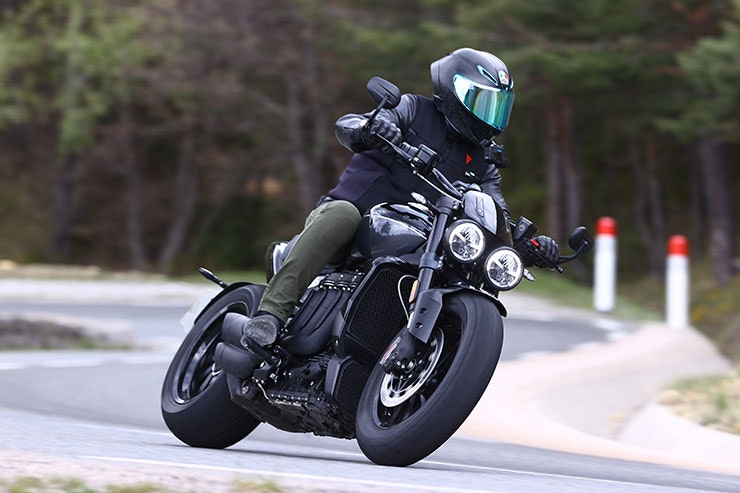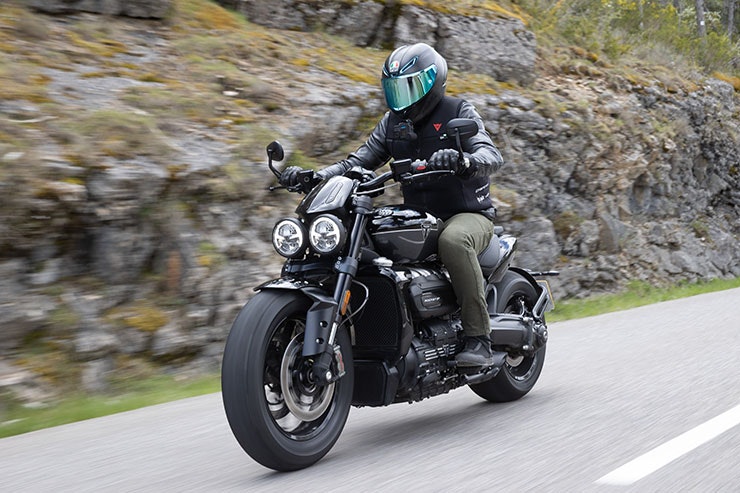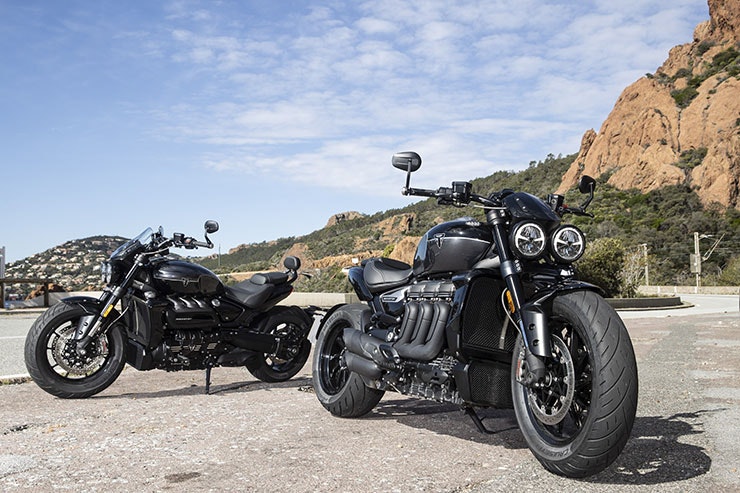Triumph Rocket 3 Storm GT/R (2024) – Review
By Michael Mann
BikeSocial Managing Editor
30.05.2024
Price: £23,195 (R), £23,895 (GT) | Power: 180bhp | Weight: 317kg (R), 320kg (GT) | Overall BikeSocial Rating: 5/5
Back in 2004 – a whole two decades ago - Triumph unveiled the original Rocket III with a plan not only infiltrate the American market, but to dominate it by outgunning rivals by unveiling a massive 2294cc three-cylinder engine muscle cruiser. Tastes have changed since then and the Rocket evolved with them to gain an even more powerful 2458cc engine plus a whole heap of tech in a ground-up revamp in 2019. In 2024 it develops again – transforming into the Rocket 3 ‘Storm’ and succeeding the Speed Triple 1200 as the company’s most powerful bike.
While the Storm name makes it sound like a special edition, all Rocket 3s from 2024 onward will be Rocket 3 Storms, available like their predecessors in sportier ‘R’ form or more touring-oriented ‘GT’ spec, each putting out 180hp compared to the 165hp of the 2019-23 versions. The changes are few and far between with alternative colours, new tyres and lighter weight wheels accompanying the Euro5+ encouraged power and torque increases.
Having ridden a 2005 model and a 2023 Rocket 3 GT back-to-back recently for a BikeSocial exclusive feature looking at the model’s 20th anniversary, ‘twas I who flew to the South of France to experience the Storm that Triumph had whipped up.
Pros & Cons
If bigger is better, the Rocket 3 is best
Euro5+ engine brings another 15hp and improved economy
A power cruiser with these dimensions shouldn’t handle as well as it does
It’s a heavy beast at low speed (though centre of gravity is still helpful)
Prices rise by £1200
Few visual upgrades over predecessor
Triumph Rocket 3 Storm: Ridden and Reviewed
Celebrating the model’s 20th anniversary, Triumph unveils the Storm edition which brings even more power from the 3-cylinder, 2.5-litre engine. Michael Mann heads to France to tame the beast.
2024 Triumph Rocket 3 Storm GT & R Price
It’s not just power that increases for 2024 with the Rocket 3 Storm, as prices are up as well. The less expensive ‘R’ version slides in at £23,195, while the GT is £700 more at £23,895 – each representing a £1200 hike over the previous generation. That’s around 5%, which in the light of recent inflation rates doesn’t seem unreasonable, particularly since you’re getting 9% more power than before.
Each version of the bike is available in three paint options. The R comes in Carnival Red over Sapphire Black, Satin Pacific Blue over Sapphire Black, or Sapphire Black over Granite. The GT flips those schemes on the fuel tank, putting Sapphire Black over Carnival Red, Sapphire Black over Satin Pacific Blue, and Granite over Sapphire Black. All the options are heavy on the black, which is traditionally the most popular colour for Rocket 3s, and the chrome and aluminium highlights of the previous models are scaled back, with black finishes on the exhausts, engine, radiator cowls, wheels and headlight surrounds.
A current example PCP deal via Triumph’s website shows that with a £5,000 deposit and a maximum of 5,000 miles per year will set you back c.£300 per month over 3 years (9.9% APR).
The three colours of the Triumph Rocket 3 Storm GT…
2024 Triumph Rocket 3 Storm GT & R Engine & Performance
Ever since its launch back in 2004 the Rocket’s centrepiece has been its massive three-cylinder engine – the largest of any production bike - and the current version’s vast 2458cc triple is still the bike’s focal point both visually and viscerally.
It’s perhaps a side effect of that vast capacity that the 15hp power increase for the 2024 Storm models has been achieved purely through changes to the engine mapping. On a smaller-engined bike you’d need a thorough redesign to achieve so much extra performance, but for the Rocket it’s been a case of finessing the tuning rather than reworking the mechanicals. The updates see the peak power rise from 165hp to 180hp, with the maximum arriving at 7000rpm instead of the 6000rpm of the previous model. It means the Rocket edges past the 177hp Speed Triple 1200 to become the company’s most powerful mass-produced bike ever. There’s a small increase in torque from 163lbft to 166lbft, still peaking at 4000rpm. That’s twice as much as a typical 1000cc superbike and feels like even more thanks to that low-revving peak.
Not only is the new bike more powerful and torquier than before, it’s also more economical and the changes to the mapping allow it to meet the latest Euro5+ emissions rules – again a benefit of the large capacity and relatively low state of tune in terms of horsepower-per-litre.
The power level and peak torque are on a par with the limited-edition Rocket 3 TFC (Triumph Factory Custom) from 2019. Only 750 of those were made, a tiny fraction of the 18,000-plus examples of the 2019-on Rocket 3 that have sold over the last five years, and the new bike manages those figures without the racy Arrow silencers of that machine.
Can you feel that extra power? Of course not. Not unless you rode them back-to-back, and even then it’d be negligible. Not that matters because increments like that become almost irrelevant, a drop in the ocean if you like. The Rocket 3’s own ocean of power is already vast – the feeling of that thrust energy as you wind it on while sitting on a 320kg cruiser requires brain adjustment. It shouldn’t be this graceful under hard acceleration, braking and cornering but it somehow manages to regulate its charisma by offering a mixture of road handling precision crossed with sophisticated madness. Rolling on the throttle to the stop takes licence-retaining bravery (or a private airfield) as the engine takes a breath before catapulting you into the next time zone which happens to be about as unique a riding experience as 2024 offers.
But you don’t need to have Tyson Fury Oleksandr Usyk’s biceps to manage it, oh no, it’s dextrous too with Triumph somehow harvesting a feeling that us riders look for, a feeling beyond satisfaction. You get off it and just grin before registering that you need to continue breathing. The inline triple makes mincemeat of the bike’s weight, and though it could be deemed buxom to manoeuvre at low speed, the user-friendly throttle/clutch combo soften that experience when plodding through town traffic. A low-slung v-shaped dry sump keeps the centre of gravity low but there’s plenty of ground clearance for more energetic riding.
For your £23-24k, you’d have expected a quickshifter. Yet exhibit A does not need one. Remarkably, the current motorcycling world has us all believing that these clutch-redundant devices are the way forwards, and I’m in full agreement. Except on the Rocket 3 where you really don’t need or want it. Its mechanically ferocity simply wouldn’t gel with a quickshifting device. Truth be told, the old technique of a slight roll at the same time as a gear lever nudge still meant no clutch was required.
…and the three options in the Rocket 3 Storm R model
2024 Triumph Rocket 3 Storm GT & R Handling & Suspension (inc. Weight & Brakes)
The extra power hasn’t required a significant rework of the Rocket 3’s chassis – and in fact there are no substantial changes to the frame or suspension.
That means you get the same aluminium frame that was introduced in 2019 – it’s half the weight of the original 2004 bike’s steel chassis – and the same Showa suspension, with 47mm USD forks and a single-sided swingarm attached to an offset, piggyback monoshock. As before, the suspension is fully adjustable, with compression and rebound damping adjustment at the front and compression, rebound and remote preload adjustment at the rear.
The brakes are unaltered, too, with Brembo Stylema M4.30 radial four-pot calipers at the front on 320mm discs and a single Brembo M4.32 four-pot at the rear on a large 300mm rotor. The brakes are helped by lean-sensitive ABS operated with the assistance of the bike’s six-axis IMU.
Despite the unaltered specs, Triumph says the new bike handles better than before thanks to one subtle update – a new set of wheels. These redesigned alloys are only 1kg lighter than the earlier design, but since that’s unsprung, rotating mass it makes a disproportionate difference to the handling, allowing the bike to change direction more quickly than before.
Although the wheels are lighter, the bike’s overall mass hasn’t dropped. The Rocket 3 Storm R comes in at 317kg wet, the Rocket 3 Storm GT at 320kg. It’s hard to compare with previous generations, which were always listed by their ‘dry’ weights, but Triumph says the overall mass is essentially unaltered.
Those new rims are wrapped in different rubber, too. The Avon Cobra Chrome tyre that were purpose-designed for the 2019-on Rocket 3 has been discontinued, so Triumph has swapped to Metzeler Cruisetec of the same sizes – 150/80-17 at the front and 240/50-16 at the back.
The Rocket 3 Storm copes with its mammoth weight, primarily due to the motor and drive train, admirably. More than admirably in fact, it disproves the perceived agility if you were to base performance on looks alone. The test ride route was carefully plotted allowing us to feel the balance and first-to-second gearshifts while negotiating rush-hour Cannes traffic, before diving around the mountains to the north of this chic town. Pointing the nose of the bike towards an apex like a sportsbike and rolling in carefully trail braking with the merest squeeze of the front lever… or pushing down on the rear brake lever if your skilled enough to balance the speed scrubbing technique, is a rewarding experience. It’s a shame we don’t have this type of road layout in the UK with the surface quality and stunning scenery to boot – otherwise everybody would have a motorbike, though the Rocket 3 felt at home here. ‘Le roi des routes’, as the locals might say.
Suspension is plush, and adjustable. I deliberately sought cracks and imperfections to feel how the bike coped, and the combination of weight and a set of adjustable Showa’s worked a treat. On a bobber-type bike, I would usually grimace if the front hit a pothole knowing that within a millisecond my backside would feel the brunt of a hard hit from beneath. There’s a sentence I don’t use every day! Not with the Rocket though. In fact, it’s rather entertaining to see the bike accelerate in a straight line – it looks like it hitches it skirt up as it powers away. The chassis and seat stay stable while the rear shock/swingarm set-up smooths out the ride (take a look at some of the on-board footage from the above video).
2024 Triumph Rocket 3 Storm GT & R Comfort & Economy
You’re probably not dropping the thick end of £25k on a 2.5-litre, 320kg cruiser if MPG is at the top of your priority list, but the new model is a fraction more economical than the 2019-23 variant, with lower emissions despite its extra power.
In standard tests, the 2024 Rocket 3 Storm models managed 42.8mpg, up from 41.45mpg for the previous version. That means the 18-litre tank gives a theoretical range of 169 miles, five miles further than you’d get from the same amount of fuel in the previous model.
Emissions, meanwhile, are rated at 152g/km CO2, down from 158g/km for the 2023 version. So you can burn more rubber without increasing your carbon footprint (or something).
Comfort is unchanged for the Storm models. As before, the R has lower bars and mid-mounted foot controls that are adjustable vertically between two positions, allied to a 773mm seat height. The more laid-back GT version has higher, pulled back bars and forward foot controls with three positions of horizontal adjustment, plus a slightly lower 750mm seat, a more comfortable yet still small pillion seat with an adjustable backrest, and three-stage heated grips as standard – which are very effective.
The biggest difference between the two models is the riding position courtesy of the footpeg and handlebar layout. I’m not a fan of the GT emphasising weight onto the bottom of your back, like a Bobber. For my 6ft frame, it’s fine for 60-or-so miles at a time, but I’d have to stretch or move around in the saddle to relieve the pressure. The sportier R is much more style, not only with the peg position but also with the front-end feel encouraging me to ride in a different style to its more relaxed brethren. That said, I’d be keen to give the GT a whirl with the footpegs set further back which would roll my weight forwards.
2024 Triumph Rocket 3 Storm GT & R Equipment
The Rocket 3 Storm’s equipment is essentially unchanged compared to the 2019-23 model, with TFT colour instruments, cornering ABS and traction control, four riding modes, cruise control and hill hold control as standard. There’s also full LED lighting and keyless ignition, along with backlit bar controls and a USB port.
Heated grips are standard on the GT and an extra-cost option on the R, while other optional extras include an up/down quickshifter with auto blip downshifts (over £500 though), a tyre pressure monitoring system and a Bluetooth connectivity module for phone-based navigation and media.
There options catalogue, as on the previous model, includes different bars, foot controls and seats to tailor the bike’s comfort, a pillion backrest, a flyscreen and various luggage options including 25-litre panniers, a 12-litre tank bag and a 9-litre tail pack.
If you’re planning to tour on the Rocket 3 then choose your model carefully. At 6ft tall, I found the R that doesn’t have a flyscreen more wind compliant than the GT which does and that ushered the breeze right into my helmet.
The switchgear and TFT screen remain untouched from the previous model, so familiarity with the layout is a bonus for those looking to upgrade. However, I can’t help but think why the Hinckley boys didn’t use the opportunity to modernise the layout, especially with the screen from the Tiger 900 and 1200 being suitable. The joystick on the left-hand side of the handlebars is still too close to the indicator switch for those with larger hands or winter gloves.
2024 Triumph Rocket 3 Storm GT & R Rivals
Picking rivals for a bike that’s defined by being the biggest is a conundrum – only one bike can carry the title of being the largest-engined production motorcycle on the market, and it’s the Rocket. But you might consider one of these:
Ducati Diavel V4 | Price: £23,595
Power/Torque: 168bhp/93lb-ft | Weight: 236kg
Harley-Davidson Fat Bob 114 | Price: £19,245
Power/Torque: 93bhp/114lb-ft | Weight: 306kg
Indian Sport Chief | Price: £20,295
Power/Torque: 89bhp/119lb-ft | Weight: 311kg
2024 Triumph Rocket 3 Storm GT & R Verdict
There’s quite simply no other bike like it, the Rocket 3 range stands alone and that tempts me. It’d be gutting therefore to pull up to another one at the lights. There’s no questioning the remarkable performance not only from that enormous engine but also with its belief belying riding dynamics too – how can a 320kg (plus this 90kg rider/writer) corner like that, brake like that, accelerate like that? And the wonderful adrenaline shot each time you’re brave enough to wrap the throttle back is wonderfully addictive, the experience of riding a Rocket 3 is a real nerve-stirrer.
If you can justify the price tag, then the other hurdle would be which of the two to choose. After some time in the saddle on this ride, I prefer the seating and riding position of the R. The GT, if anything, accentuates weight on the coccyx and I felt a little disconnected from the front wheel when getting more, er, enthusiastic with the mountain road challenges.
Minor niggles aside including the lack of practicality, the Rocket 3 will live long in the history books of motorcycling in general, not just Triumph. They will be a future classic because of their pound-for-pound (£-for-lbs) value and overall class-of-one fame. Well done Triumph for answering the question nobody knew they needed to ask, it takes a fair dollop of bravado to create something so ostentatious, excessive, grand and indulgent… and it works so well. It’s the antidote to boring.
If you’d like to chat about this article or anything else biking related, join us and thousands of other riders at the Bennetts BikeSocial Facebook page.
2024 Triumph Rocket 3 Storm GT & R - Technical Specification
Looking for motorcycle insurance? Get a quote for this motorbike with Bennetts bike insurance
What is MCIA Secured?
MCIA Secured gives bike buyers the chance to see just how much work a manufacturer has put into making their new investment as resistant to theft as possible.
As we all know, the more security you use, the less chance there is of your bike being stolen. In fact, based on research by Bennetts, using a disc lock makes your machine three times less likely to be stolen, while heavy duty kit can make it less likely to be stolen than a car. For reviews of the best security products, click here.
MCIA Secured gives motorcycles a rating out of five stars (three stars for bikes of 125cc or less), based on the following being fitted to a new bike as standard:
A steering lock that meets the UNECE 62 standard
An ignition immobiliser system
A vehicle marking system
An alarm system
A vehicle tracking system with subscription
The higher the star rating, the better the security, so always ask your dealer what rating your bike has and compare it to other machines on your shortlist.


